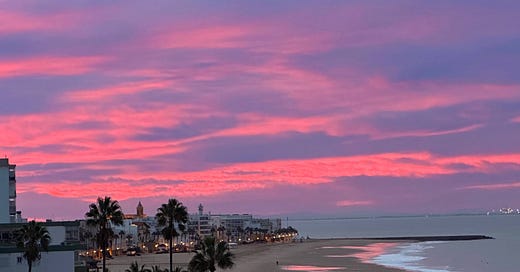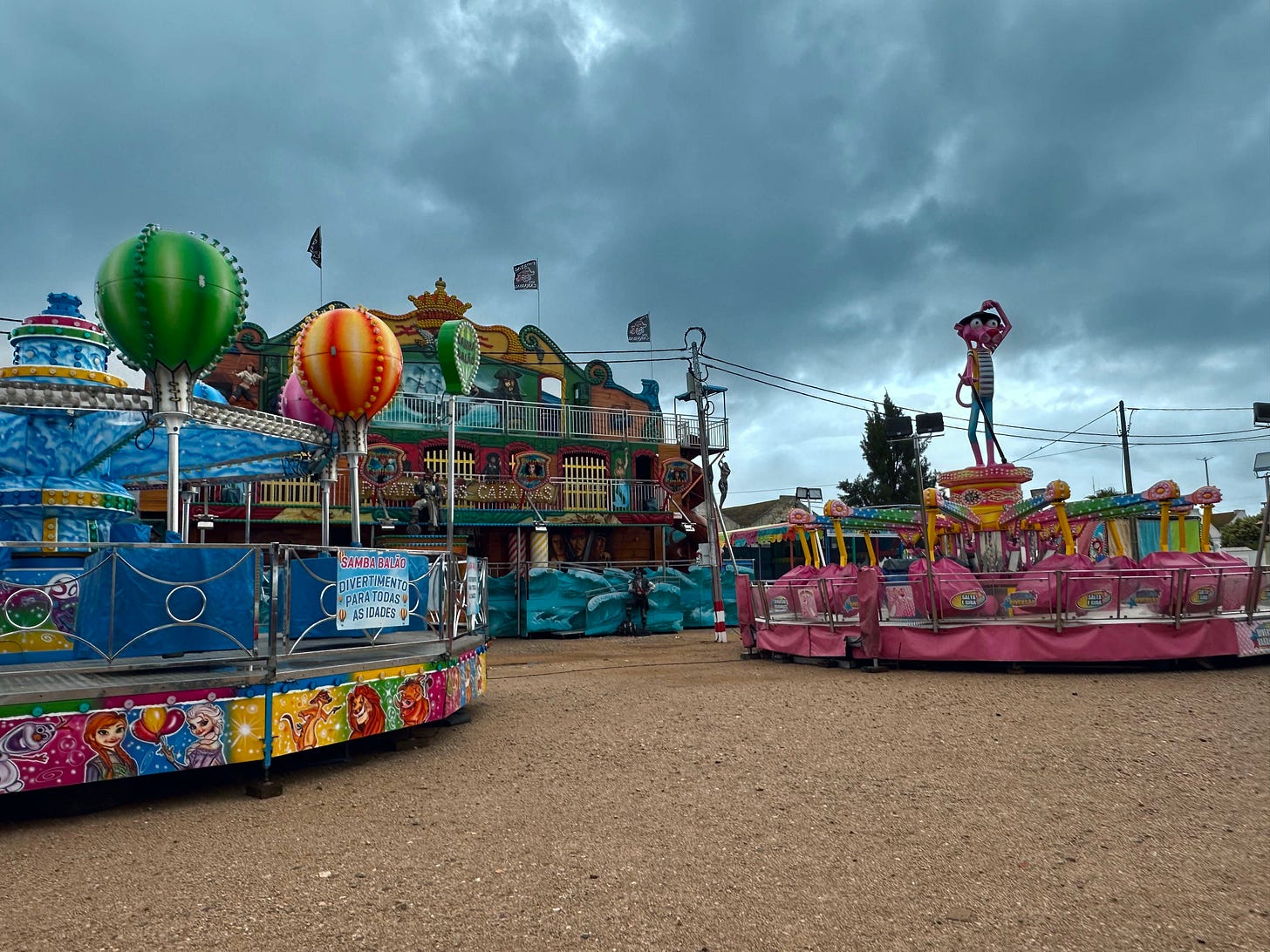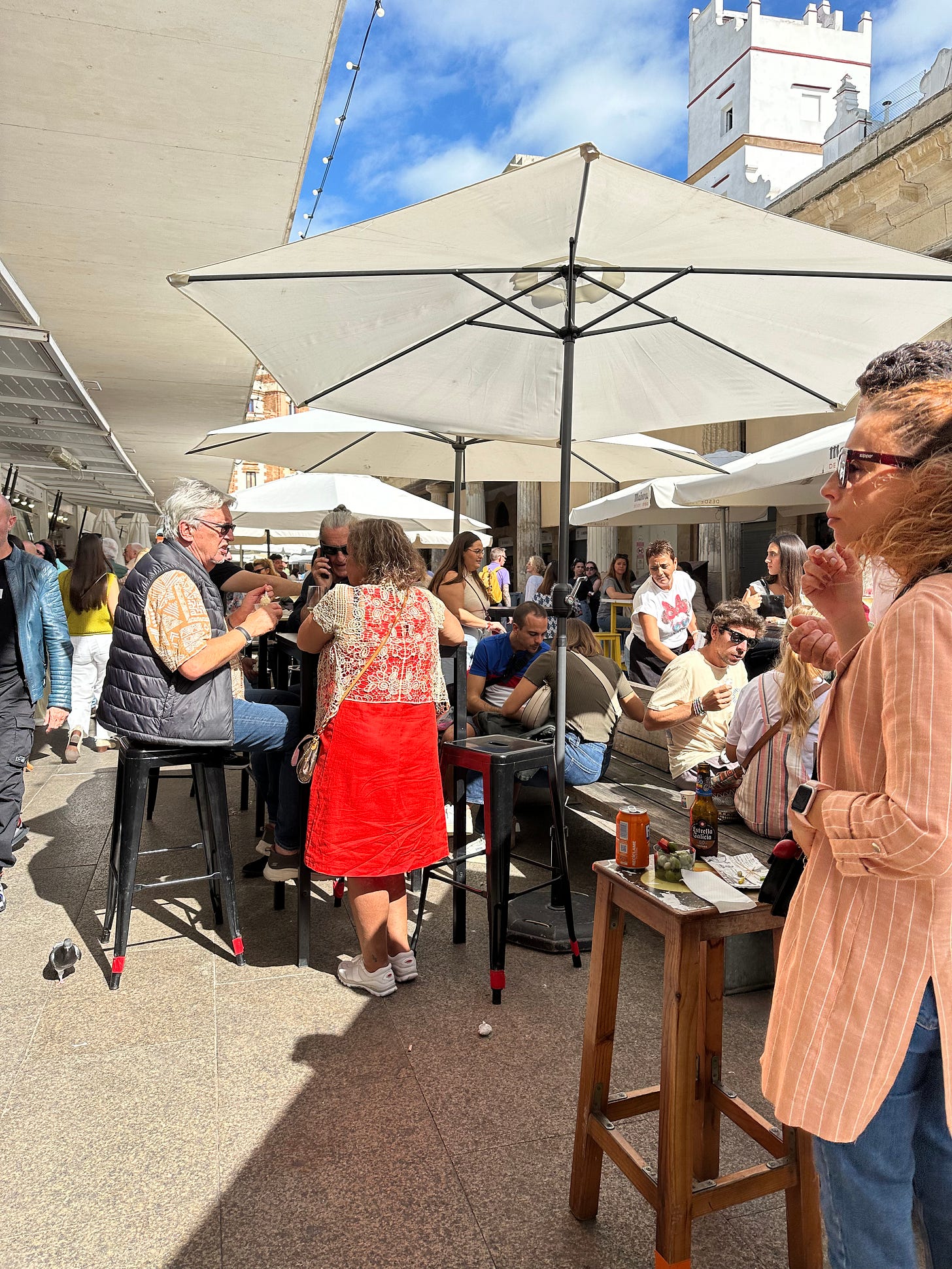Today, we temporarily suspend our recounting of summer travels to write about Cádiz. Like Córdaba, it is a city name that I have to practice in my head a few times before I say it out loud.1
Get Out of Town
As October approached, our small town erected rows of stalls in our typically beautiful praça (town square) and on the “river” road. Our worst nightmare (actually a temporary inconvenience) was coming to town…the Feira da Praia. We hurriedly made plans to get out of town. We didn’t want to drive too far … we wanted to take Onix, and I wanted to hear the ocean when I woke. Denise wanted me to renew my military ID. We would get an AirBnb in Rota and check out Cádiz.
As it turned out, it rained every day the Feira was in town. As such, the noise from the amusement area, which typically continues until 02:00 was non-existent. And instead of ending on Saturday (when we planned to be away), it ended on the day we left town. I admit we have a tendency not to do enough research or planning before we travel.
Cádiz
As is our custom, we began our exploration of Cádiz with a free walking tour. The 2.5-hour tour provided a great introduction to the city. The guide provided excellent recommendations for free museums, churches, and the ancient Roman theater pictured above. After the tour, we enjoyed lunch at the local Mercado (more about this below) and then made the 45-minute drive2 back to Rota to hang out with Onix in the old city of Rota and on the beach. We would return on Saturday for a deeper dive.
If you visit Cádiz, you will want to visit the Roman Theater. Built in the 1st century BC, a fortress was built on top of it in the 13th century. Featuring a seating area that could accommodate 10,000 spectators, it was discovered in 1980. An ancient church (formerly a mosque) is on one side, and apartments surround two sides. I can’t imagine what it must be like to live in one of those apartments, gazing down at those ancient steps and out to the sea beyond.
We also recommend you visit the Cádiz Museum featuring Phoenician and Roman artefacts as well as 16th-20th century paintings. The couple you see above are 2 of the 3 sarcophagi that have been unearthed in Europe and date back to the 5th century BC. Their discovery is a story in and of itself. The necropolis was discovered in 1887, about 15 feet below a planned maritime exhibition. While workers ran off with many of the treasures found around the grave, a male sarcophagus was discovered buried in rock and sealed with carved marble. Archaeologist Pelayo Quintero Atauri came to Cádiz in 1904 and became obsessed with the sarcophagus. He believed that there was a female one as well and searched for her tirelessly until he left the city in 1939.
Interestingly, in a twist of fate worthy of a Frank Capra movie, on September 26, 1980, while excavating for the foundations of a new building on Ruiz de Alda street in Cádiz, a Phoenician female sarcophagus dating back to around 470 BC was discovered. Not only that, but the building that previously occupied the site had been the villa of the archaeologist Pelayo Quintero himself. — Guillermo Carvajal
Two Lessons Learned
If you plan to visit any Spanish city, I want to end with two invaluable lessons. The first relates to lunch in the Mercado. Fact: the stalls that circle a Mercado are among the best places to have lunch in Spain. But it is also a fact that there are far fewer places to sit than there are customers. On the second day, after careful observation, I learned how to snag a table like a local.
First, keep in mind that each stall has its own tables. If you buy lunch from Vendor A and attempt to sit at an empty table put out by Vendor B, you will be firmly told to leave.
Second, hover. Once you have decided where to eat, spend a few minutes scoping out which occupied table is most likely to leave first. There will be some guesswork involved … a Spanard can spend 90 minutes enjoying a half-empty glass of rioja. Meanwhile, send your companion off to buy a beverage from the target restaurateur.
When your companion returns, sheepishly make eye contact with an occupant at the target table and politely ask if they mind you resting your glass of wine or beer on the table. “Puedo?”
If they agree, you have got it! Send your companion off to buy your meals, and by the time they get back, the current occupants of the table will have likely left or will leave when they see her return.
The second lesson we actually learned when we first moved to Algarve. It is that Spanish city streets are empty between 14:00 and 17:00.3 Yes, siesta is a real thing … even in the 21st century. So if you need some alone time or want to take your dog for a walk off-lead, plan accordingly.
Sim, recomendamos a visita a Cádis
Nanc
Note that the accent (emphasis) is on the first syllable. As Americans, we wanted to say kə-DIZ, but the locals say KA(H)D-iz.
There is a ferry that runs between Rota and Cádiz. We chose to drive (and pay €15 to park for 5 hours each day) because we needed to get back to Onix.
Photoshopping was NOT required for the photo above.










Funny coincidence since I followed you: we used to live in Berlin, where you visited this summer - now in Porto- and we also visited Cadiz in July- we got to witness Spain’s victory over England at the Euro live in Cadiz and were duly sprayed by a water hose on a placa afterward while celebrating. Cadiz is a beautiful, vibrant, interesting city with fantastic food from so many original and diverse restaurants. The park, the outdoor cafes and the sea near by! Most of all, we enjoyed the joie de vivre, which is unparalleled in Spain. Btw, I wasn’t that impressed by the quality of the food at the Mercado - it’s fine for a lunch and worth the experience - but there are small, beautiful restaurants around the Mercado that serve excellent food - our free walking tour guide was amazing - and her recommendations proved spot on.
i could have sworn that was onyx's head. lol